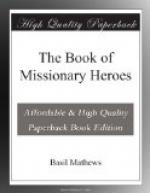The cold, clear sunlight of a winter morning on the high plateau of Asia Minor shone into the clean, white ward of a hospital in Konia (the greatest city in the heart of that land). The hospital in which the events that I am going to tell in this story happened is supported by Christian folk in America, and was established by two American medical missionaries, Dr. William S. Dodd, and Dr. Wilfred Post, with Miss Cushman, the head nurse, sharing the general superintendence: other members of the staff are Haralambos, their Armenian dispenser and druggist, and Kleoniki, a Greek nurse trained by Miss Cushman. The author spent the early spring of 1914 at the hospital in Konia, when all the people named above were at work there.
The tinkle of camel-bells as a caravan of laden beasts swung by, the quick pad-pad of donkeys’ hoofs, the howl of a Turkish dog, the cry of a child—these and other sounds of the city came through the open window of the ward.
On a bed in the corner of the ward lay a bearded man—a Turk—who lived in this ancient city of Konia (the Iconium of St. Paul’s day). His brown face and grizzled beard were oddly framed in the white of the spotless pillow and sheets.
His face turned to the door as it opened and the matron entered. The eyes of the Turk as he lay there followed her as she walked toward one of her deft, gentle-handed assistant nurses who, in their neat uniforms with their olive-brown faces framed in dark hair, went from bed to bed tending the patients; giving medicine to a boy here, shaking up a pillow for a sick man there, taking a patient’s temperature yonder. Those skilled nurses were Armenian girls. The Armenians are a Christian nation, who have been ruled by the Turks for centuries and often have been massacred by them; yet these Armenian girls were nursing the Turks in the hospital. But the matron of the hospital was not a Turk, nor an Armenian. She had come four thousand miles across the sea to heal the Turks and the Armenians in this land. She was an American.
The Turk in bed turned his eyes from the nurses to a picture on the wall. A frown came on his face. He began to mutter angry words into his beard.
As a Turk he had always been taught, even as a little boy, that the great Prophet Mohammed had told them they must have no pictures of prophets, and he knew from what he had heard that the picture on the wall showed the face of a prophet. It was a picture of a man with a kind, strong face, dressed in garments of the lands of the East, and wearing a short beard. He was stooping down healing a little child. It was our Lord Jesus Christ the Great Physician.
As Miss Cushman—for that was the name of the matron—moved toward his bed, the Turk burst into angry speech.
“Have that picture taken down,” he said roughly, pointing to it. She turned to look at the picture and then back at him, and said words like these: “No, that is the picture of Jesus, the great Doctor who lived long ago and taught the people that God is Love. It is because He taught that, and has called me to follow in His steps, that I am here to help to heal you.”




